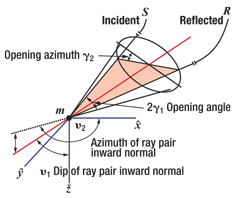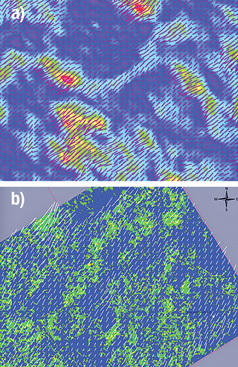In situ full-azimuth decomposition of the seismic wavefield yields seismic signatures and diagnostic properties that are unbiased by acquisition sectoring.
Duane Dopkin and Joanne Wang, Paradigm
Established gas plays in shale formations in North America have achieved high visibility as technology plays with the successful application of fracture stimulations, microseismic data, geosteered horizontals and new completion strategies to characterize and exploit this distinctive class of unconventional plays. These successes can be carried over to emerging shale plays, creating new opportunities for the oil and gas industry to improve the hydrocarbon recovery factor and mitigate the cost and risk associated with drilling activities.
Surface seismic data can also play a substantive role in gas shale plays. Recently, rich-azimuth and wide-azimuth seismic surveys have been acquired to enhance the total value of these shale assets through improved imaging quality, resolution and new deliverables, including representations of fracture or stress orientation and intensity. While it is clear that the industry has made tremendous strides in sampling the surface with these rich seismic acquisitions, the same claim cannot be made with regard to the sampling of the subsurface. To accommodate the rich azimuths in legacy and modern onshore and offshore acquisitions, the industry has come to rely on acquisition sectoring of the recorded seismic data and the subsequent independent processing and imaging of these sectors (usually eight). Unfortunately, the subsurface directional data, resolution and image integrity is compromised and biased by the limitations of the sectoring approach. As a consequence, the return on investment for these rich seismic acquisitions is compromised.
To overcome these limitations, a fundamentally different imaging approach is required to provide geoscientists and engineers with new data and perspectives that can improve their exploration and production programs. To this end, a new method, full-azimuth decomposition and imaging, is proposed for application to gas shale reservoirs to secure a better understanding of subsurface stress directions and intensity. The process, designed to sample the subsurface in every direction in a continuous manner, results in new data structures and images that provide a novel way for geoscientists to interact with seismic data and to characterize the shale plays with more confidence and with more data.
EXPLOITING SEISMIC
Oil companies and seismic contractors have made huge investments in wide and rich seismic data acquisitions to improve the illumination of potential reservoirs beneath complex structures (e.g., salt and basalt); to provide images that more clearly qualify reservoir compartmentalization or permeability (e.g., fracture density, orientation); or to produce angle- and azimuth-dependent reflectivity that can be transformed, with confidence, to descriptive reservoir properties.
These data acquisition upgrades, however, have not always translated into a full or proportional return on investment in the resultant seismic image and interpretation. While these images clearly incorporate some of the benefits from these rich acquisitions (e.g., noise suppression, substructure imaging), application of current technology and approaches often falls short in realizing the full return from these data sets. To achieve this potential, conventional seismic imaging and analysis programs require a significant “azimuthal” upgrade that deals with this extra dimension in a full, continuous and accurate manner.
Conventional seismic imaging and interpretation procedures sector the recorded data into a small and manageable number of acquisition offset, or azimuthal, sectors. The sectoring approach is generally performed without consideration given to the mapping of recorded seismic data to subsurface image points. Consequently, images are averaged over sectors, and these sectors may not correlate to in situ measurements made directly on subsurface structures.
The alternative procedure performs a full wavefield decomposition and mapping of the recording wavefield making use of an in situ reference frame referred to as the local angle domain. The process returns full-azimuth image gathers that can be used to construct a variety of diagnostic seismic deliverables suitable for the determination of stress orientation and intensity. We present a bit of theory and follow with an example of the application of the full-azimuth imaging decomposition and inversion to a Barnett Shale field data set.
CREATING NEW DATA STRUCTURES AND IMAGES
The new approach endeavors to decompose the recorded seismic wavefield into continuous full-azimuth images that will provide both observable and measurable data for stress orientation and intensity determination.
Imaging systems involve the interaction of the incident and reflected wavefields at the image points. Each wavefield can be decomposed into local plane waves (or rays), indicating the direction of propagation. The direction of the incident and scattered rays can be conventionally described by their respective polar angles. Each polar angle includes two components—dip and azimuth. Therefore, a set of four scalar angles is required to define an angle-domain imaging system at a given image point.
In the proposed system, decomposition and imaging of the seismic wavefield are performed using a rich bottom-up ray trace procedure based on an exploding diffractor model.1 Ray tracing is performed in all angles and all directions to achieve a uniform illumination of each image point. All arrivals are taken into account, and phases are preserved.
The imaging stage involves combining a very large number of ray pairs (or pairs of local plane waves) representing the incident and reflected/diffracted rays. Each ray pair maps seismic data recorded on the free surface into the four-dimensional local angle domain (LAD) space. In our notation, these angles are dip v1 and azimuth v2 of the ray-pair normal, half-opening angle γ1 and opening azimuth γ2. Figure 1 shows an example of a selected ray pair (incident and scattered) and the four angles associated with the LAD.
 |
|
Fig. 1. An example of a selected ray pair (incident and scattered) and the four angles associated with the LAD.
|
|
The result of this decomposition in the LAD is two types of full-azimuth gathers (reflection and directional) sampled continuously and in depth.
Although the system is able to generate both full-azimuth directional and reflection angle gathers, the objectives of the Barnett Shale project to which it was applied relied heavily on the dynamic and kinematic properties of the full-azimuth reflection angle gathers.
Figure 2 shows a single full-azimuth reflection angle gather. Figure 2a captures a single panel (azimuth) of this continuous gather. It is displayed in a cylinder to support interactive motion and operations through all azimuths. Figure 2b also shows a single panel (azimuth) from the full-azimuth gather with opacity applied to the data in the cylindrical gather to highlight the full-azimuth reflectors in the vicinity of the Barnett Shale. Figure 2c highlights the seismic reflector associated with the top Ellenberger carbonate formation. The Ellenberger underlies the Barnett Shale and captures the influence of the stress events and vertical fractures in the Barnett Shale. The saddle shape of this 3D reflector is a strong signature of anisotropy with a horizontal axis of symmetry, or horizontal transverse isotropy (HTI). The slow velocity direction (normal to maximum stress direction) is indicated by the orientation (N32E) of the seismic panel.
.jpg) |
|
Fig. 2. A full-azimuth reflection angle gather from the Barnett Shale.
|
|
Figure 3 shows the same full-azimuth reflection angle gather, unwrapped over the azimuth and opening angle. The undulating reflector is the top Ellenberger reflector, where the periodic moveout behavior is associated with anisotropic stress. Clearly, the full-azimuth gathers define a new data structure fully sampled in azimuth and highly suitable for both residual moveout and amplitude-versus-angle (AVA) inversion procedures.
.jpg) |
|
Fig. 3. Unwrapped full-azimuth reflection angle gather. Note the undulating appearance of the Ellenberger reflector (circled in red).
|
|
RESIDUAL MOVEOUT INVERSION
Residual moveouts measured along the continuous full-azimuth reflection angle gathers of Figs. 2 and 3 can be used to obtain effective HTI model parameters.2
The estimation of the effective model parameters is performed in two stages. First, the background (HTI/VTI) velocity model is used, along with the reflection angles, for converting the measured residual moveouts (or traveltime errors) into azimuthally dependent normal-moveout (NMO) velocities. Then, a Fourier transform is applied to convert the NMO velocities into the azimuthal wave-number domain to obtain the effective HTI model parameters: vertical time, vertical compression velocity, Thomsen parameter delta and the azimuth of the medium axis of symmetry.
The inversion procedure can be performed over maps or sub-volumes. The inversion was performed over the top Ellenberger Formation to obtain HTI parameters (minor velocity, major velocity, delta and azimuth of the axis of symmetry). A vector map (azimuth of the axis of symmetry) with a stress intensity backdrop is displayed in Fig. 4a.
 |
|
Fig. 4. Stress orientation and intensity maps from full-azimuth residual moveout inversion (a) and AVA inversion (b).
|
|
AVA INVERSION
AVA inversion is applied to the full-azimuth gather.3 The inversion is an extension to the Ruger equation, where HTI properties (intercept, gradient, anisotropic gradient and fracture orientation angle) can be extracted at each depth sample by fitting surfaces to the full-azimuth angle-domain gather. These properties are extracted along the top Ellenberger and shown in Fig. 4b. The results are in general agreement with the results of the residual-moveout inversion. Both results are subject to the influences of the disrupting karst features. Nevertheless, the full directional (azimuthal) sampling of residual moveouts and amplitudes provides tremendous stability to the solution without compromises or data limitations.
CONCLUSIONS
A full-azimuth and full-wavefield decomposition and imaging system is presented for the determination of stress orientation and intensity. By performing an in situ, full-azimuth decomposition of the seismic wavefield, we are able to observe seismic signatures and extract diagnostic properties that are unbiased and uncompromised by the acquisition sectoring processes and procedures. It is believed that this new imaging method will make seismic data more relevant in gas shale plays by increasing the hydrocarbon recovery factor, lowering finding and development costs and directly impacting stimulation programs.
LITERATURE CITED
1 Koren, Z., Ravve, I., Ragoza, E., Bartana, A. and D. Kosloff, “Full-azimuth angle domain imaging,” presented at the 78th SEG Annual International Meeting, Las Vegas, 2008.
2 Koren, Z., Ravve, I. and R. Levy, “Effective model for HTI/TTI layered media,” presented at the 79th SEG Exposition and Annual Meeting, Houston, 2009.
3 Canning, A. and A. Malkin, “Azimuthal AVA analysis using full-azimuth 3D angle gathers,” presented at the 79th SEG Exposition and Annual Meeting, Houston, 2009.
|
THE AUTHORS
|
 |
Duane Dopkin is a Geophysicist and Senior Vice President for Paradigm. He worked at Digicon Inc. and CogniSeis Development Inc. Mr. Dopkin holds a BS degree in geosciences from The Pennsylvania State University and an MS degree in geosciences from the University of Houston at Clear Lake.
|
|
| |
Joanne Wang is Manager for Integrated Geoscience Workflow Development at Paradigm. She is responsible for developing integrated workflows in the areas of reservoir characterization, pore pressure prediction, velocity model building and time-to-depth conversion. Ms. Wang holds an MS degree in geophysics from China University of Geosciences.
|
|


.jpg)
.jpg)



